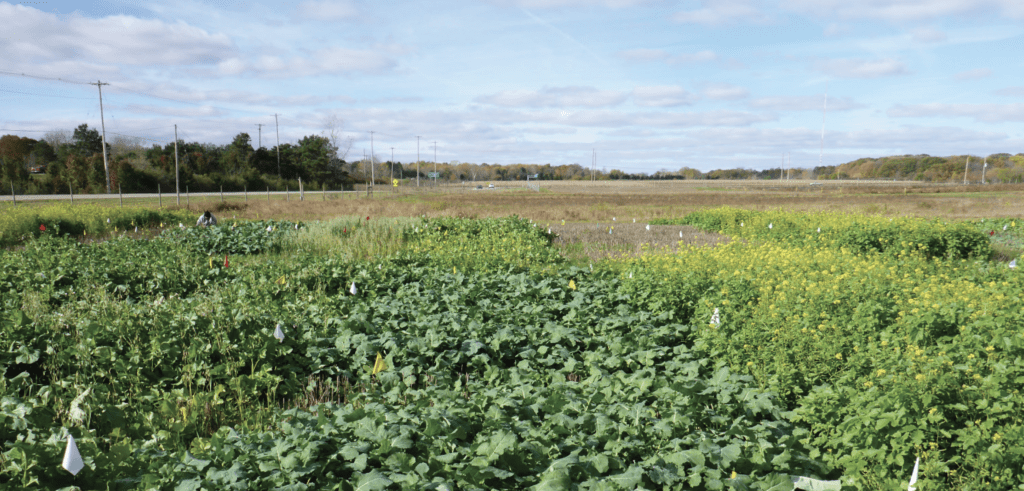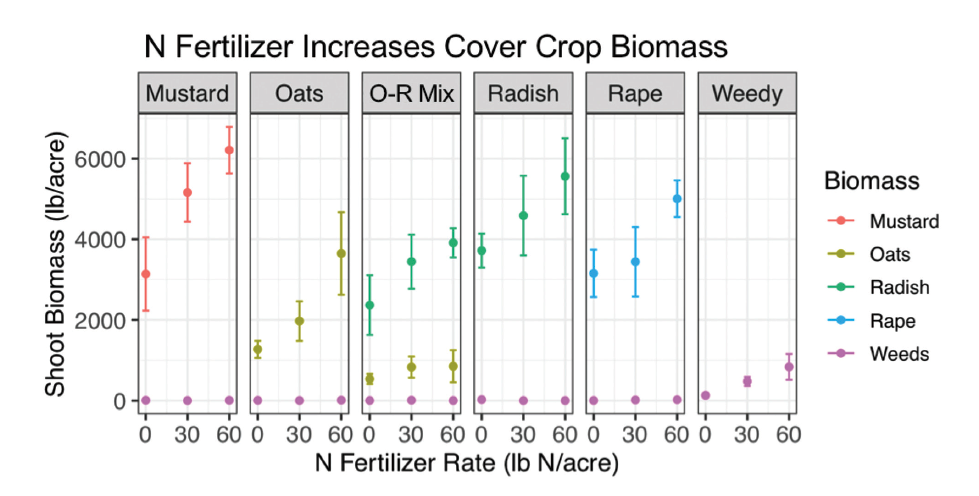

Jul 15, 2019Nitrogen boosts late-summer cover crops
Cover crops can play an important role in promoting the health and fertility of agricultural soils. In addition to adding organic matter, cover crops have the potential to provide a number of services that can benefit a following vegetable crop, including reducing erosion, suppressing weeds, scavenging and supplying nutrients, and influencing pest populations. In some cases, these services may lead to vegetable yield and quality improvements, although smart management is needed to minimize risks.
Success with cover cropping begins with selecting species that will do well in your available planting window and that align with your primary goals. In many vegetable production systems in the northern U.S., the late summer window (often after harvest of an early-season vegetable crop or winter wheat) provides a good opportunity to fit a range of cover crop species in the rotation. The Midwest Cover Crop Council’s cover crop selector tool is an excellent online resource to help you decide on the right cover crop to plant.
However, getting the most out of a cover crop doesn’t stop there. How cover crops are managed can make a big difference in the benefits they provide. Biomass production is closely related to many cover crop services, and management practices that increase cover crop growth can improve performance. For example, in a multi-year on-farm study evaluating the impacts of late summer cover crops on carrot production, mustard family cover crops that were planted in early August and fertilized with about 30 pounds of nitrogen (N) accumulated more biomass and resulted in greater weed suppression, N recycling, and carrot yield improvements than those that were not.
It may not be surprising that on sandy or otherwise low fertility soils, a little N fertilizer may go a long way towards improving the performance of non-legume cover crops. However, N fertilizer represents one more cost for a crop you won’t be harvesting, and may run contrary to the conservation goals of cover cropping if it contributes to additional N losses to the environment. On the other hand, if it leads to yield improvements in a high-value vegetable crop it could quickly pay for itself, and counterintuitively, a fertilized cover crop may do a better job reducing fall N leaching due to increased growth.
We are currently conducting a study to evaluate the benefits and tradeoffs of applying moderate amounts of N fertilizer to late summer cover crops on sandy soils in Michigan, and wanted to share our first-year results to provide some food for thought.


Graphic: Michigan State University
Experiment details. Late summer cover crop treatments included oat (var. ‘Ida’), oilseed radish (var. ‘Defender’), an oat-oilseed radish mixture, yellow mustard (var. ‘Ida Gold’), and rapeseed (var. ‘Dwarf Essex’), in addition to a weedy (no cover crop) control. The covers were no-till drilled into standing wheat stubble in early August of 2017 on a loamy sand soil in Holt, Michigan. Each treatment was then fertilized after planting with either 0, 30, or 60 pounds of N/acre applied as broadcast urea. With the exception of Dwarf Essex rapeseed, all of these cover crops generally winter kill in Michigan. We collected data on cover crop and weed biomass and N accumulation in the fall, as well as soil N availability the following spring after cover crop termination.
Impacts of N fertilization. Under the conditions of this study, N fertilizer significantly increased the growth of all late summer cover crops (Figure 1). While the response varied by species, shoot biomass increased from 50-180% with the addition of 60 pounds of N/acre. In particular, the biomass of yellow mustard and oats more than doubled when 60 pounds N/ac was added. These increases are likely conservative since they do not include root biomass. Weed growth also increased with added N in the no cover crop control; however, where cover crops were present they suppressed weeds regardless of N rate.
N accumulation was considerable for the cover crops – yellow mustard, for example, accumulated over 3 tons of dry matter/acre, which translates into more than 200 pounds of N/acre contained in the cover crop shoots alone. Interestingly, in all cases the additional shoot biomass N resulting from N fertilization was equivalent to or exceeded the amount of N actually added in fertilizer (data not shown). This suggests that moderate levels of N fertilization of these late summer cover crops has the potential to significantly increase growth without increasing risks of N leaching. In addition, soil N levels in the spring were greatest following fertilized mustard family cover crops, indicating the potential to scavenge and recycle greater amounts of N to benefit subsequent vegetable crops.
Management implications. The take-home message is that the use of modest amounts of N fertilizer may be a good investment to help you get the most out of a late summer cover crop without negatively impacting the environment. However, the likelihood of benefits will depend on the situation. First, don’t waste N fertilizer on fields that are unlikely to need it. Stick to sandy or low organic matter soils or fields otherwise likely to be low in N fertility due to prior crop uptake, leaching precipitation, N immobilization (following wheat, for example), or other factors. Second, make sure you have the right cover crop and planting window – N fertilizer may be counterproductive for legumes, and it won’t help much in general if there’s insufficient time for growth before winter kill or termination.
While more research is needed to evaluate the economics and potential benefits across various cover crops and vegetables, if you’re already investing in a cover crop, it’s worth considering management practices that will optimize its potential to do the most good.
– Zachary D. Hayden, Michigan State University
Above, A view of the late summer cover crop N rate experiment in Michigan in November 2017. Photo: Michigan State University














